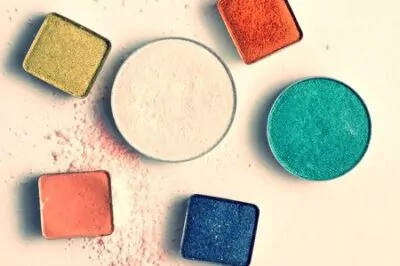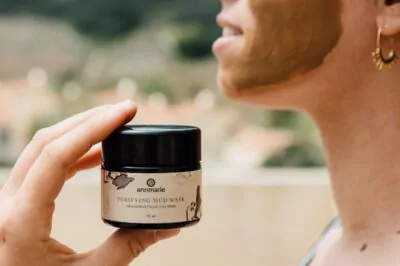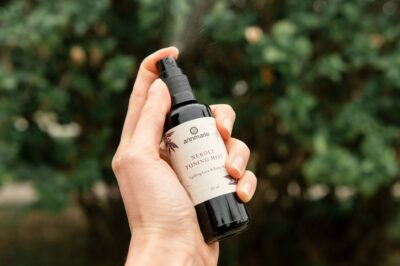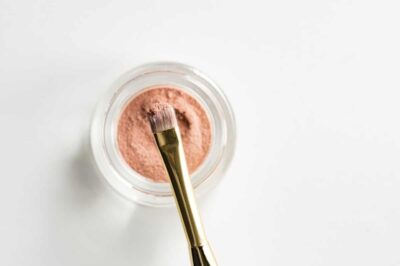Table of Contents[Hide][Show]
Ladies, we all know what menopause means. Most of us saw our mothers go through it. The hot flashes. The night sweats. The mood swings. The dry skin.
We know it’s coming, but we sure don’t want to rush it.
What if we’re doing just that by using standard over-the-counter makeup products?
Sounds impossible, right?
Maybe not, according to a recent study from researchers at Washington University School of Medicine in St. Louis. Turns out that women with high levels of certain chemicals in their bodies—some of which can come from makeup—experience menopause two to four years earlier than women with lower levels of these chemicals in their systems.
Is it really the makeup? If so, what can we do, besides go barefaced?
Study Finds Link Between Chemicals in the Blood and Early Menopause
For the study, researchers used data from the National Health and Nutrition Examination Survey (NHANES) on about 31,000 women, gathered between 1999 and 2008. These women had undergone blood and urine tests. Researchers examined the tests for about 110 chemicals suspected of interfering with hormones in the body (endocrine disruptors).
Some of these chemicals included the following:
- Dioxins: Chemical byproducts that are known animal carcinogens. Over 50 cosmetic ingredients may be contaminated with this chemical, including sodium myreth sulfate, PEG, oxynol, ceteareth, oleth, polyethylene, and more.
- Phthalates: Chemicals used to make plastics and as solvents. Found in cosmetic products like nail polish, hairsprays, makeup, lotions, liquid soaps, and perfumes.
- Polychlorinated biphenyls (PCBs): Industrial chemicals used in coolants, insulating materials, and lubricants.
- Phenols and phenolic derivatives: Man-made chemicals produced from petroleum and used in making plastics and related materials. Found in dental sealants, sunscreen, lotions, hand soap, and toothpaste.
- Organophosphate pesticides: Common insecticides used in farming and agriculture.
- Surfactants: Chemical cleansing agents. Found in cleansers, body washes, liquid soaps, and more.
- Polycyclic aromatic hydrocarbons (PAHs): A group of over 100 chemicals formed during the incomplete burning of coal, oil, gas, garbage, tobacco, and even charbroiled meat. Also man-made to make dyes, plastics, and pesticides. Present in some shampoos and hair dyes.
The researchers focused most on chemicals known to be hormone disruptors—those that can interfere with how estrogen, the female hormone, functions in the body. Their results showed:
- Women with high levels of certain hormone-disrupting chemicals experienced menopause about 2 to 4 years earlier than women with low levels of these chemicals.
- Women with high exposures to endocrine-disrupting chemicals (EDCs) were up to 6 times more likely to be menopausal than those with low levels.
- Researchers identified 15 EDCs “that warrant closer evaluation” because of their potentially detrimental effects on ovarian function. These included PCBs, pesticides, phthalates, and furan (a toxic chemical used in chemical manufacturing industries and found in low levels in some canned or jarred foods).
Though this study doesn’t prove that using personal care products is going to lead to early menopause, it does show that chemicals we’re all exposed to on a daily basis can have negative effects on hormonal health.
Early Menopause Isn’t Just Inconvenient
Early menopause is more than just an inconvenience. It’s actually a health condition called “primary ovarian insufficiency.”
When premature menopause does occur, it can put women at risk for other health problems, including the following:
- Heart disease
- Osteoporosis
- Neurological diseases
- Cerebral aneurysms
- Depression, anxiety, and mood changes
- Negative body image
- Dyspareunia (painful intercourse)
We already know that conditions like thyroid disease, rheumatoid arthritis, lupus, medical treatments, infections, epilepsy, and Addison’s disease, can cause early menopause. Now we’re discovering that chemicals like those listed above may also affect the ovaries, decreasing activity and causing a drop in estrogen that leads to menopause.
Other Evidence of Chemical-Induced Early Menopause
It’s not such a great leap to imagine that chemicals in our cosmetics and in our environment could have an effect on menopause. A number of other studies have already suggested this possibility.
One of the biggest concerns are plasticizers—chemicals like BPA and phthalates. They have been linked to an increased risk of diabetes, asthma, and other health issues, and have been found to affect hormones in humans.
The bad news is that according to the Centers for Disease Control and Prevention (CDC), there is “widespread” exposure to these chemicals in the American population. In addition, adult women have higher levels of phthalates than men—phthalates that are used in soaps, body washes, shampoos, cosmetics, and similar personal care products.
- A 2012 study found that BPA and phthalates may be linked to lower thyroid levels. At high levels of exposure, the chemicals could reduce thyroid hormones by 10 percent.
- A 2013 study found that BPA may have a direct effect on fertility in women, and may affect the maturation of the egg. Researchers also noted that BPA could affect chromosomes, potentially increasing the risk for birth defects.
- In 2011, researchers reported that chemicals in common household products like non-stick pans, clothing, furniture, carpets, and paints were associated with early menopause. The specific chemicals were perfluorocarbons (PFCs), chemicals linked to cancer and thyroid disease in animal studies.
- The National Institute of Environmental Health Sciences states that endocrine disruptors may interfere with the body’s hormonal systems, potentially increasing risk of fertility problems, some cancers, and causing developmental, reproductive, neurological, and immune effects in people and wildlife. These chemicals, they note, include dioxins, pesticides, plasticizers (like BPA and phthalates), and polychlorinated biphenyls. All can be found in plastic bottles, metal food cans, detergents, flame-retardants, food, toys, cosmetics, and pesticides.
Though some of these chemicals are beyond our control—they’re present in the soil, water, and air—many are in the skin and makeup products we use everyday. That means that by being selective with what we put on our skin, we can reduce our exposure and hopefully the risks associated with it.
Click Here to Check Out Our Nontoxic Makeup
Are you concerned about toxins and early menopause? Do you have tips for reducing exposure? Please share them with our readers.
Sources:
Natalia M. Grindler, et al., “Persistent Organic Pollutants and Early Menopause in Women,” PLoS One, January 28, 2015, doi: 10.1371/journal.pone.0116057, http://journals.plos.org/plosone/article?id=10.1371/journal.pone.0116057.
Diane Duke Williams, “Earlier menopause liked to everyday chemical exposures,” Washington University in St. Louis, January 28, 2015, https://news.wustl.edu/news/Pages/menopause-chemicals.aspx.
Jane Muncke, et al., “Food packaging and migration of food contact materials: will epidemiologists rise to the neotoxic challenge?” J Epidemiol Community Health, doi: 10.1136/jech-2013-202593, http://jech.bmj.com/content/early/2014/01/28/jech-2013-202593.
Andrew McDougall, “Study links early menopause to everyday exposure—but NOT cosmetics!” Cosmetics Design, January 30, 2015, http://www.cosmeticsdesign-europe.com/Formulation-Science/Study-links-early-menopause-to-everyday-exposure-but-NOT-cosmetics.
John D. Meeker, Kelly K. Ferguson, “Relationship between Urinary Phthalate and Bisphenol-A Concentrations and Serum Thyroid Measures in U.S. Adults and Adolescents from the National Health and Nutrition Examination Survey (NHANES) 2007-2008,” Environ Health Perspect. July 2011; 119:1396-1402; http://ehp.niehs.nih.gov/1103582/.
Ronit Machtinger, et al., “Bisphenol-A and human oocyte maturation in vitro,” Human Reproduction, July 30, 2013; 28(10):2735-2745, http://humrep.oxfordjournals.org/content/28/10/2735.
Ben Forer and Suzan Clarke, “Study: Chemical in Many Household Products Associated with Early Menopause,” ABC News, March 25, 2011, http://abcnews.go.com/Health/study-chemical-household-products-early-menopause/story?id=13212353.








Yes , every thing we put “in” our bodies and “on” our bodies is dangerous for us (except for our new age doctors and nutritionalists that give information about our” wrongs” in our world of lies )from” people” in high places…
It seems impossible to avoid the chemical mine-field. I was so pleased that you were creating the Minerals by Annmarie makeup until I read your update re:the ingredients. I was disappointed to see that it contains titanium dioxide, which both my daughter and myself are allergic to. So…I guess we’ll both continue to go bare faced. Thanks for giving me the opportunity to write.